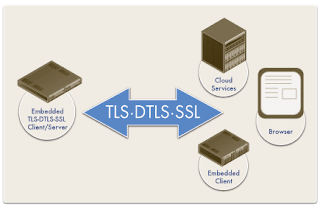Improving SSL VPN performance with DTLS
Networks
are increasingly faster, mainly, because the method of access to the
medium is faster than ever with up to 100
Gigabit Ethernet today.
However, protocols are improving too as we
saw with Multipath
TCP or Moving
the Web from TCP to UDP but,
today, I would like to highlight how to improve VPN (Virtual
Private Networks) because I've
already written
about VPN
Security, Overlay
Technologies like PBB,
SPB
or VxLAN,
and Metro
Ethernet Services as well like
E-Line
VPWS and E-LAN VPLS, but I've never
written about performance and improvements in Dial-up VPN for remote
users.
Using
TCP for making SSL VPN isn’t already a good idea
because TCP was design for running over unreliable or slow base
connection where it is
useful with
segment retransmission and flow control
through windowing. However, if we configure
a SSL VPN over TCP and we send TCP traffic to the remote
side, we could get a poor
performance due to the fact that we are encapsulating TCP over TCP
and, as a result, there will be mismatching
timers between the upper and the lower layer TCP connection, which
will increase retransmission and losing packets.
 |
| SSL VPN over TCP with TLS - Stack |
How
can we improve SSL VPN performance? As TCP
over TCP is a bad idea, we can use
UDP for VPN tunneling with the DTLS protocol for security. In
this way, traffic
is protected like the traditional SSL VPN with
TLS but, this time, we’ll use DTLS for communications security and
UDP for improving networking performance. As
a result, the lower layer doesn’t worry about segment
retransmission and flow control, because this task is carried out by
the upper layer, thus
the throughput and performance of the SSL VPN will be much better.
 |
| SSL VPN over UDP with DTLS - stack |
FortiOS
5.4 and the new
FortiOS 5.6 already support SSL VPN
over UDP with DTLS
to improve SSL VPN performance.
If we want to configure it, we need to run
the next commands by CLI.
 |
| Using DTLS to improve SSL VPN performance |
Once
we’ve enabled dtls-tunnel, the FortiGate opens the UDP port, as
well as the TCP port, for SSL VPN.
 |
| Local In Policy of FortiGate |
However,
we’ll have to
configure the FortiClient as
well for using DTLS becuause it only uses TCP by default. If we want
to use DTLS tunnels from FortiClient, we’ll have to download a
backup configuration from FortiClient and change the parameter
preferred_dtls_tunnel
to 1. After changing this parameter, we’ll have to upload the
configuration to FortiClient. Once this
configuration is done, FortiClient will connect to SSL VPN using UDP
with DTLS first and if it fails, FortiClient will connect to SSL VPN
using TCP with TLS.
 |
| FortiClient Configuration |
Next,
we can see a traffic capture using TCP with TLS for SSL VPN.
 |
| SSL VPN over TCP with TLS |
We
can also see a traffic capture using UDP with DTLS for SSL VPN, which
offers better performance for remote users.
 |
| SSL VPN over UDP with DTLS |
Regards
my friends. I hope you’ve enjoyed with
this how-to and you’re planning to migrate to DTLS your SSL VPN.









excelente! me sirvio para unas conexiones cliente vpn por el tema este del coronavirus...vamos a estar poniendo DTLS! gracias!
RépondreSupprimerexcelente informacion, gracias
RépondreSupprimer